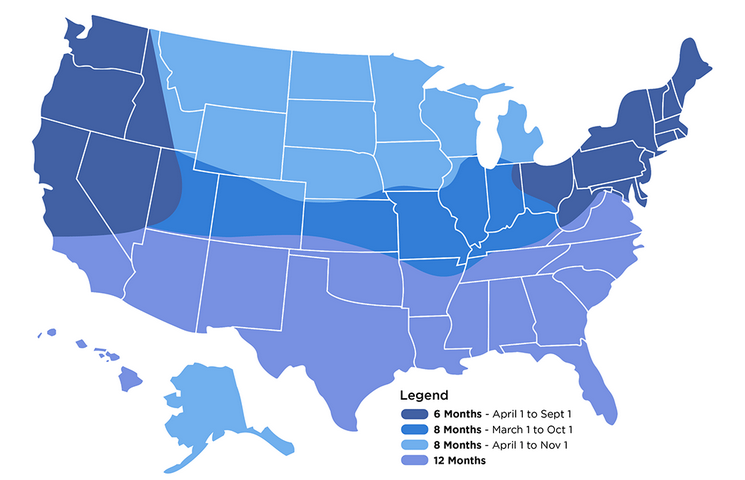Winter is coming, and as the weather turns colder, pond maintenance tactics tend to shift a bit. While some areas of the country can forgo using pond treatment products during the winter, others are advised to continue using these products throughout the winter.
Several years ago, we developed the treatment map shown below to give our clients a general idea of how many months and during which months they should use our pond treatment products.

In general, when the temperature of the water in your pond is 45° F or higher, you need to treat it. Typically, when the water temperature is below this point, there will be little to no growth of green organic matter.
In most cases, the map above is a good guide to follow, but, of course, Mother Nature has a mind of her own and some years might have an early spring or late autumn and you may want to treat for a longer period of time or perhaps for less time. For instance, our own state of Minnesota was experiencing snowy weather and near-freezing temperatures several weeks ahead of our treatment end date of Nov. 1.
Of course, it’s important to note that the air temperature and water temperature are not going to be the same, and you must use the water temperature as your guide. The water temperature still might be 45° F or higher, even if the air temperature is colder, so while those snowy Minnesota days might have dropped the air temperature rapidly, the water temperature won’t decline nearly as quickly.
Keep in mind, the size of your pond is important. Shallower ponds will drop in temperature more quickly than a deeper pond. If you have a small pond, such as a koi pond, it is essential that you constantly keep an eye on that water temperature as well as the water level, to ensure that your fish have enough water and that water quality is not being impacted by fluctuations in temperature.
In the southern United States, the water temperature rarely drops low enough to stop pond treatment. There may be certain mountain areas where lake temperatures drop below 45° F but that’s rare. Continuous treatment throughout the year, therefore, is the best way to keep green organic matter from propagating.
Our All-Natural Pond Treatment Products
At Healthy Ponds, we have developed several all-natural products. Each product uses a proprietary blend of beneficial bacteria for ponds. Our beneficial bacteria consumes the excess nutrients in your pond water, reducing sludge and reducing green organic matter.
Our AquaSpherePRO® is an easy-to-use monthly pond water treatment. Simply toss in enough biodegradable spheres to accommodate the approximate number of gallons of water in your pond. They will sink to the bottom of the pond and begin releasing beneficial bacteria. The spheres will treat the pond water for up to 30 days, and then you can simply add new spheres.
This monthly treatment may be all you need to maintain a healthy pond. However, sudden temperature spikes, consistently high temperatures or events such as a large rainfall can alter the balance in your pond, causing the rapid growth of unwanted green organic matter. For these situations, we have several all-natural supplements.
Natural Blast®, for example, is an ideal supplement to have on hand in the early spring, when temperatures may begin to spike. The all-natural beneficial bacteria in Natural Blast® reduces excess nutrients and breaks down the organic matter that clouds pond water. It works across the entire water column to treat common water problems that cause clarity, quality and severe odor issues.
If you already have a stagnant pond and need to remediate issues such as a large amount of heavily matted, floating organic matter, our product Rush® can be a good choice. This product is spread directly on top of the problem and can be used as an alternative for copper.
Both Natural Blast® and Rush® can and should be used in conjunction with the AquaSpherePRO®.
Beyond Pond Treatment: Get Your Pond Ready For Winter
Whether you live in an area prone to long stretches of freezing weather or you live in a warmer climate, a thorough autumn clean up can ensure that your pond will be better able to accommodate rising temperatures in the spring and summer months. Here are a few steps that we recommend you take in order to maintain a clean pond.
- Remove Dead Leaves – When leaves and other debris enter your pond, they sink to the bottom and eventually form a sludge layer. A thick sludge layer can cause a drop in oxygen levels, which can harm fish and other wildlife, and once the temperatures climb, this lack of oxygen can accelerate the growth of green organic matter.
However, cleaning fall leaves and debris out of your pond is just one step you need to take. It also is wise to remove as many fallen leaves as possible from your yard so that these leaves don’t blow into your pond water.
- Trim & Prune – Remove dead branches, trimming back trees and pruning bushes and shrubbery also help keep these items out of your pond. Pruning trees and other plants can ensure that they are in the best shape possible, as well.
To determine which treatment options are the best fit for your pond or water feature, simply go to our home page and click on the “Start Your Treatment” tab. If you have any questions about winter pond treatment or our products, feel free to give us a call or contact us via email at any time.

